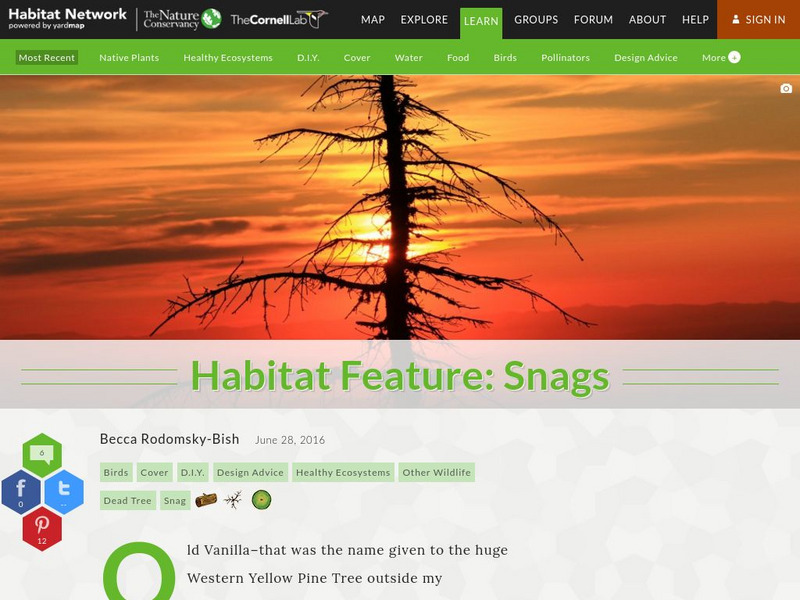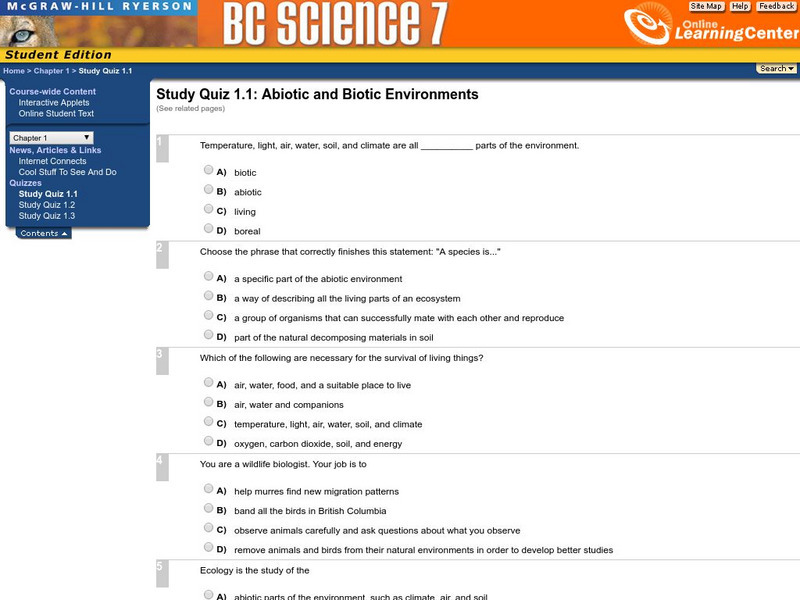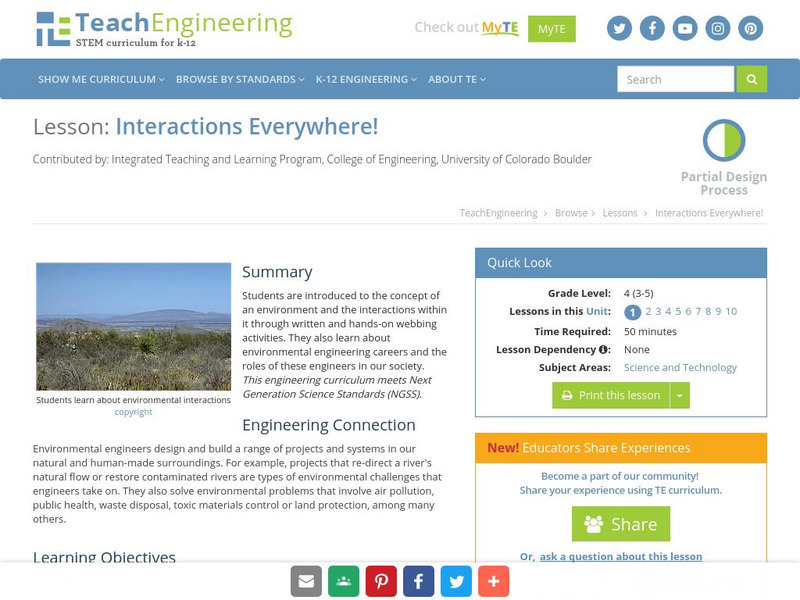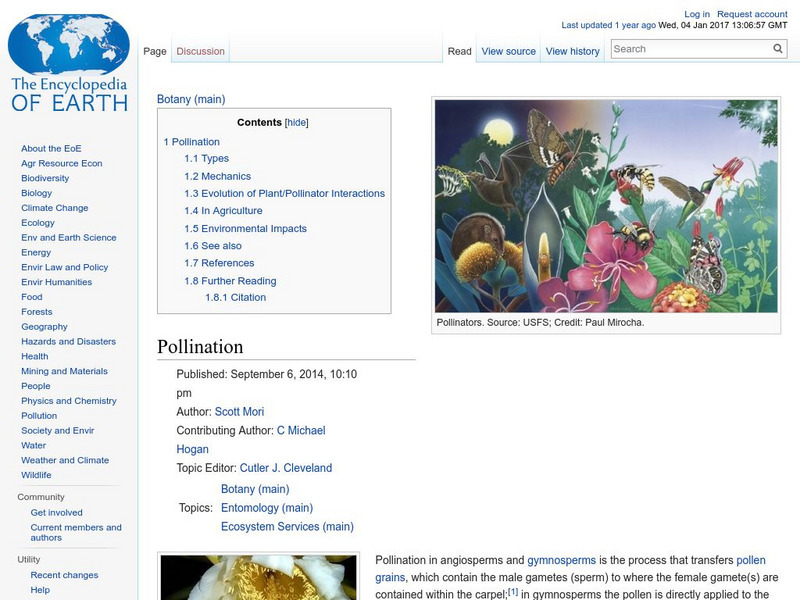McGraw Hill
Glencoe Online: Abiotic Factors
Take this 8 question check quiz on abiotic factors. The quiz is multiple choice.
CPALMS
Florida State University Cpalms: Florida Students: Diving the Depths of Underwater Life
A tutorial that explores how and why the distribution of aquatic life is affected by abiotic factors, such as light, temperature, and salinity.
Science Education Resource Center at Carleton College
Serc: Healthy Waters
By the end of this lesson, students will understand how we can use macroinvertebrates to determine the quality of water in a river or stream.
Cornell Lab of Ornithology
Habitat Network: Habitat Feature: Snags
Find out how dead trees can be beneficial to a backyard habitat.
Cornell Lab of Ornithology
Habitat Network: Snags: Nature's Apartment Complexes
Find out why the sometimes hazardous or untidy dead trees are actually quite important to wildlife.
Climate Literacy
Clean: Temperature and Precipitation as Limiting Factors in Ecosystems
Learners correlate graphs of vegetation vigor with those of temperature and precipitation data for four diverse ecosystems, ranging from those near the equator to the poles, to determine which climatic factor is limiting growth.
PBS
Pbs Learning Media: Living and Nonliving
What is it that distinguishes a living organism from a nonliving object? This collection of images presents examples that aren't as clear-cut as one might think, enticing students to question the meaning of life.
CK-12 Foundation
Ck 12: Episd: What Are Biomes?
[Free Registration/Login may be required to access all resource tools.] Students will consider the influences that create different biomes. Recognize and classify the types of biomes.
CK-12 Foundation
Ck 12: Episd: Ecosystems
[Free Registration/Login may be required to access all resource tools.] Explore ecosystems and ecology on an introductory level uncovering fact about types of ecosystems and the competitive exclusion principle.
SMART Technologies
Smart: Living and Nonliving Things
Students define the characteristics of living and non-living things, identify living and non-living components of an ecosystem, and identify the roles of organisms in living systems.
McGraw Hill
Mc Graw Hill Ryerson: Abiotic and Biotic Environments
Take this ten question quiz on abiotic and biotic environments. The quiz is multiple choice.
Sophia Learning
Sophia: Abiotic and Biotic Factors: Lesson 4
This lesson will introduce abiotic and biotic factors, giving examples and comparing/contrasting the two. It is 4 of 4 in the series titled "Abiotic and Biotic Factors."
Sophia Learning
Sophia: Abiotic and Biotic Factors: Lesson 1
This lesson will introduce abiotic and biotic factors, giving examples and comparing/contrasting the two. It is 1 of 4 in the series titled "Abiotic and Biotic Factors."
National Geographic
National Geographic: Ocean Abiotic Factors
Students define and provide examples of abiotic and biotic factors of different ecosystems. Then they investigate the importance of abiotic factors and physical processes within ocean ecosystems.
Oswego City School District
Regents Prep: Ecosystems/communities
Abiotic factors vary in the environment and determining the types and numbers of organisms that exist in that environment. Factors which determine the types and numbers of organisms of a species in an ecosystem are called limiting...
Science Education Resource Center at Carleton College
Serc: Investigating the Long Meadow Lake Unit of Valley Nat'l Wildlife Refuge
This is a field investigation at the Bass Ponds Trailhead area in the MN Valley National Wildlife Refuge in which students will collect data in the field and samples to test back in the classroom. Students will try to elicit the...
Other
Vida: Living and Non Living Things
Study these four images when learning about living and nonliving things.
BiologyWise
Biology Wise: Facts About Autotrophs and Heterotrophs
Explains what autotrophs and heterotrophs are, the several types of each, their roles in an ecosystem's food chains, and the differences between them.
TeachEngineering
Teach Engineering: Interactions Everywhere!
This lesson introduces students to the concept of an environment and the interactions within it through written and hands-on webbing activities. The lesson also introduces students to environmental engineering careers and their roles in...
Encyclopedia of Earth
Encyclopedia of Earth: Botany: Pollination
Scientific article detailing what pollination is, types of pollination, animals (mainly insects) that facilitate pollination, ways pollination can take place, its evolution, pollination in agriculture, and threats to pollination....
Georgia Department of Education
Ga Virtual Learning: Ap Biology: Ecology
Students review the study of living things and make connections back to Earth's systems. This unit focuses on how various species, grouped in populations and communities, work with the nonliving things around them to ensure survival.
Science Education Resource Center at Carleton College
Serc: Our Big Backyard: How Does Our Local Ecosystem Change During the Year?
Get students observing the environment around their school with this activity. In this lab experiment, students keep a journal containing written observations and digital pictures of how local flora and fauna change during the school year.
TeachEngineering
Teach Engineering: Environmental Interactions
In this activity, students create a "web" to identify and demonstrate the interactions among the living and non-living parts of an environment. This information allows students to better understand what an environment is and to also...
Other
Hub Pages: Abiotic Factors: A Component of Ecosystem
In the environment, there are external factors that really affect organisms living within it. One of these factors is the set of abiotic factors, or nonliving variables, such as wind, ocean, day length, rainfall, temperature, and ocean...
Other popular searches
- Abiotic and Biotic Factors
- Abiotic and Biotic
- Abiotic and Biotic Elements
- Abiotic and Biotic Resources
- Abiotic and Biotic Environment





















